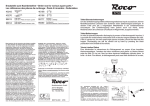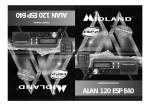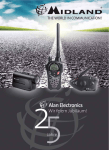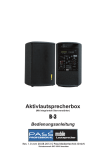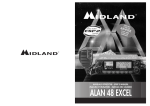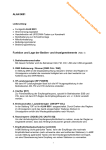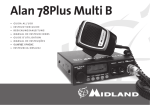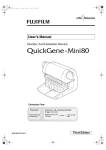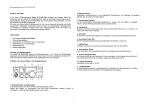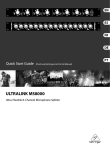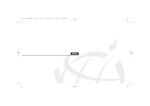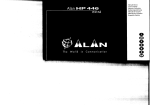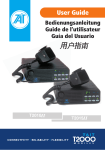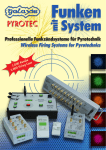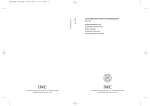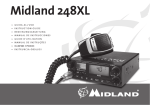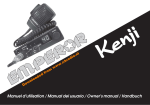Download ALAN 199-A - CBradio.nl
Transcript
cop 199 a 3 12 2002 14:21 Pagina 1 ® ® MANUALE D’USO - USER’S MANUAL - MANUEL D’UTILISATION BEDIENUNGSANLEITUNG - MANUAL DEL USUARIO ALAN 199-A Downloaded from www.cbradio.nl cop 199 a 3 12 2002 14:21 Pagina 2 • SCHEMA BLOCCHI • BLOCK DIAGRAM • SCHÈMA A BLOCS • BLOCKSCHALFBILD • DIAGRAMA DE BLOQUES ISTR.199-A 3-12-2002 14:24 Pagina 1 INDICE Principali funzioni ............................................................................2 Comandi ..........................................................................................2 Installazione ....................................................................................3 Sostituzione del fusibile ..................................................................4 Connessione del microfono ............................................................4 Montaggio dell'antenna ..................................................................4 Antenna base ..................................................................................5 Canali prioritari (CH 9-19) ..............................................................6 Altoparlante supplementare ............................................................6 Caratteristiche tecniche ..................................................................7 ALAN 199-A è un nuovo ricetrasmettitore veicolare, di dimensioni ridotte, che opera in modalità AM. Di facile ed immediato utilizzo, ALAN 199-A dà la possibilità di selezionare la potenza di uscita e quindi può essere utilizzato in tutti quei paesi europei che consentono la normativa AM, nel rispetto della EN 300-433. 1 I TA L I A N O Uso del ricetrasmettitore ................................................................6 ISTR.199-A 3-12-2002 14:24 Pagina 2 PRINCIPALI FUNZIONI • Il PLL permette un controllo preciso delle frequenze e maggior stabilità su tutti i 40 canali, con controlli separati di scansione verso l’alto e verso il basso. • I filtri ceramici proteggono dalle interferenze dei canali adiacenti. • Display con visualizzazione canali • Commutatore 4W/1W per selezionare la potenza di emissione. • Il LED rosso (TX) e il verde (RX), indicano la modalità operativa: RX= ricezione; TX= trasmissione. • La regolazione del circuito squelch permette di eliminare i fastidiosi rumori in fase di ricezione. • La presa esterna sul retro consente l’utilizzo di un eventuale altoparlante supplementare. • Il commutatore d’emergenza permette la commutazione immediata sul CH 9 o CH 19. • Connettore antenna SO239 COMANDI Commutatore canali prioritari CH-9/19 Display canali Led RX/TX ALAN 199-A 9 CH 19 40 4W 1W Presa microfono SQUELCH ON/OFF VOL Squelch Accensione Volume RX TX CHANNEL Commutatore 4W/1W Tasto cambio canale Presa altoparlante esterno ANT EXT SPKR + RED - BLK SERIAL NO. Connettore antenna 2 Cavo alimentazione ISTR.199-A 3-12-2002 14:24 Pagina 3 INSTALLAZIONE Dadi Dadi Rondelle Viti Viti Rondelle Staffa Rondelle Viti e rondelle Vite Ricercare e localizzare sul mezzo mobile, la posizione per l’installazione dell’apparato. Tale posizionamento deve essere fatto in modo da non creare intralcio a chi guida, e nello stesso tempo, di facile accessibilità per poter togliere l’apparato secondo le necessità. La posizione di montaggio più comune è sotto il cruscotto (si sconsiglia vicino a fonti di calore o vicino al condizionatore). Dopo aver stabilito la posizione più adatta sul veicolo, mantenere il ricetrasmettitore con la staffa di montaggio nell’esatta posizione desiderata e verificare che non ci siano inconvenienti; successivamente segnare e forare il veicolo per il fissaggio delle viti di montaggio. Controllare che esse siano ben ancorate, in considerazione delle notevoli sollecitazioni e vibrazioni create dal mezzo mobile. EXT ANT SPKR +RED -BLK Collegare il filo rosso (con il fusibile) al positivo della batteria. Collegare il filo nero al negativo della batteria (solitamente questo è il telaio dell’auto) tenendo conto che una connessione corretta e stabile è indispensabile per il buon funzionamento dell’apparato. 3 I TA L I A N O Rondelle ISTR.199-A 3-12-2002 14:24 Pagina 4 Per l’installazione in auto, la tensione a 13,8 Vcc è solitamente prelevabile dal contatto ausiliario dell’interruttore d’accensione. Questo evita che l’apparato possa rimanere acceso accidentalmente quando l’autista scende dall’auto e permette inoltre di poter operare senza che il motore sia in funzione. Prima di operare, installare e collegare l’antenna inserendo il connettore nell'apposita presa sul retro dell’apparato. Per l’uso di un altoparlante esterno, utilizzare la presa EXT-SPKR. SOSTITUZIONE DEL FUSIBILE Sostituire il fusibile del cavo di alimentazione con un similare a 2 A (Un fusibile di ricambio è in dotazione). CONNESSIONE DEL MICROFONO La presa del microfono è situata sul davanti dell’apparato. Premere il piccolo pulsante sulla presa microfonica e inserire il microfono. Per toglierlo, ripremere lo stesso pulsante ed estrarre il microfono. Accertarsi sempre che il connettore sia ben connesso alla presa. MONTAGGIO ANTENNA L’antenna è l’elemento più importante per ottenere i migliori risultati. È indispensabile che l’antenna abbia un’impedenza di 50 Ohm. A seconda della posizione in cui viene installata, il rendimento varia notevolmente. Usare un cavo coassiale con impedenza 50 Ohm. Sono consigliati i cavi RG 58U per lunghezza sotto i 2.5 metri, oppure RG 8 per lunghezze superiori. Il cavo coassiale deve essere montato con molta cura: evitare curve e piegamenti. Inoltre va ricordato che il cavo più corto aumenta la sensibilità dell’apparato, così pure un cattivo collegamento tra apparato e antenna. Consigli: • Montare l’antenna nel posto più libero e più alto dell’auto. • L’antenna deve essere installata in posizione verticale, e così deve rimanere anche quando il veicolo è in moto. • Montare l’antenna e il cavo il più possibile lontano da fonti di rumore. • La massa dell’antenna deve coprire un’area di 1m2. Esistono in commercio diversi tipi di antenna: con stilo a 1/4 d’onda; alimentate al centro; con carica in base; con carica in alto. Le antenne caricate sono più corte, ma per un miglior rendimento si consigliano quelle di lunghezza di circa 2 metri. L’installazione a centro tetto è la migliore in senso assoluto perché il ground o radiale di terra è proporzionale in tutte le direzioni, mentre su una fiancata o in una qualsiasi altra parte del veicolo, diventa proporzionale alla massa dello stesso (es: se l’antenna è installata posteriormente, diventa direttiva in avanti, cioè i segnali provenienti dalla 4 ISTR.199-A 3-12-2002 14:24 Pagina 5 parte opposta sono meglio ricevuti, così dicasi anche per quelli trasmessi). N.B.: con l’ausilio di un accoppiatore a due vie, l’antenna montata anteriormente può sostituire l’antenna della radio FM. ANTENNA BASE Per l’utilizzo del ricetrasmettitore in stazione fissa (base) occorre un alimentatore con una tensione di 12-13.8V capace di erogare una a corrente continua di 2A. Si consiglia un’antenna 1/2 onda omnidirezionale per comunicazioni a medio e lungo raggio. 5 I TA L I A N O Posizioni comuni di montaggio dell'antenna ISTR.199-A 3-12-2002 14:24 Pagina 6 USO DEL RICETRASMETTITORE Ricezione: 1. 2. 3. 4. 5. 6. 7. 8. 9. Assicurarsi che il filo rosso sia connesso ad una tensione di 12-13.8 V. Controllare che l’antenna e il microfono siano ben connessi. Posizionare il commutatore d’emergenza sulla posizione centrale. Scegliere la potenza di emissione con la quale si intende operare. Girare la manopola squelch nella massima posizione antioraria. Accendere l’apparato mediante la manopola VOLUME. Ricercare il canale desiderato attraverso i tasti CHANNEL. Regolare il volume come desiderato. Regolare lo squelch. Questo comando viene utilizzato per eliminare il rumore di fondo del ricevitore in assenza di segnali d’ingresso. Per la massima sensibilità del ricevitore è preferibile che il comando sia regolato solo al preciso livello dove il rumore di fondo del ricevitore o il rumore ambientale, viene eliminato. Girare completamente in senso antiorario poi lentamente in senso orario finché non scomparirà il rumore. Qualsiasi segnale affinché possa venir ricevuto, dovrà essere leggermente più intenso rispetto alla media del rumore ricevuto. Un ulteriore rotazione in senso orario aumenterà il livello di soglia che il segnale dovrà superare per poter essere udito. Se lo squelch sarà posizionato nella massima posizione in senso orario, si potranno sentire solo segnali molto forti. Trasmissione: 1. Selezionare il canale desiderato. 2. Premere il pulsante di trasmissione sul microfono, parlare mantenendo una distanza dalle labbra dai 5 a 8 cm. 3. Per ricevere, rilasciare il pulsante di trasmissione. N.B.: gridare nel microfono non aumenta la portata della trasmissione, in quanto un circuito interno automaticamente commuta la massima modulazione. Si consiglia quindi di usare un tono di voce normale. CANALI PRIORITARI (CH 9-19) L’ALAN 199-A è dotato di un commutatore che permette di posizionarsi immediatamente sui canali 9 e 19. Il canale 9 serve solo per le comunicazioni di emergenza. Il canale 19 invece è usato per richiedere informazioni sulla viabilità, ecc. Posizionando l’interruttore nella posizione centrale si ritornerà all’ultimo canale selezionato. ALTOPARLANTE SUPPLEMENTARE Inserire un altoparlante con potenza da 3-10 W nella presa EXT-SPKR. In questo modo l’altoparlante interno viene disconnesso. 6 ISTR.199-A 3-12-2002 14:24 Pagina 7 CARATTERISTICHE TECNICHE RICEVITORE Gamma di frequenza ..................................................................da 26.965 a 27.405 Sensibilità..............................................................migliore di 1.0 µV per 20 dB S/N Reiezione canali adiacenti ......................................60 dB (10 KHz); 70 dB (20 KHz) Frequenze IF........................................................1° IF=10.695 MHz; 2° IF=455 KHz Potenza d’uscita audio ............................................................................4.5 W max Risposta in frequenza ..................................................................6 dB:450-2500 Hz Modulazione incrociata ..........................................................................45 dB o più Squelch ..........................................................................regolabile da 1.2 µV a 1mV TRASMETTITORE Potenza d’uscita........................................................................................4 W / 1 W Modulazione ........................................................................................................AM Modulazione massima ......................................................................................90% Emissioni spurie ....................................................................................62 dB o più Tolleranza di frequenza ......................................................................più di 0.002% Alimentazione ................................................................................................13.8 V Corrente assorbita max ......................................................................................2 A Impedenza antenna ......................................................................................50 Ohm Dimensioni ....................................................................................124x38x190 mm Peso ................................................................................................................1.2 kg 7 I TA L I A N O Gamma di frequenza ..................................................................da 26.965 a 27.405 ISTR.199-A 3-12-2002 14:24 Pagina 8 ISTR.199-A 3-12-2002 14:24 Pagina 1 CONTENTS Main functions ......................................................................................2 Controls ................................................................................................2 Installation ............................................................................................3 Replacing fuse ......................................................................................4 Connecting the microphone ..................................................................4 Antenna system ....................................................................................4 Base station antennas ..........................................................................6 Priority channels CH9/19 ......................................................................7 Remote speaker operation ....................................................................7 Technical specifications ........................................................................8 ALAN 199-A is a small size, new mobile transceiver, operating in AM modality. Easy and practical to use, it has the possibility to select the output power; therefore, it can be used in all the European countries that allow the AM regulation, in accordance with EN 300 433. 1 ENGLISH Using your transceiver ..........................................................................6 ISTR.199-A 3-12-2002 14:24 Pagina 2 MAIN FUNCTIONS • Phase Locked Loop circuitry gives precise frequency control and stability over all 40 channels: pinpoint channel tuning accuracy with separate scan up and down controls. • Ceramic filters give superior selectivity and freedom from adjacent channel interference. • 4W/1W switch to select the transmitting power • LCD Display showing the selected channel. • Red Led (TX) and Green Led (RX) show the operative modality: TX= transmission; RX= reception. • Hysteresis-type Squelch circuit automatically compensates for signal fading to eliminate signal “chopping” during message reception. • Emergency switch lets you switch to channel 9 or 19 - instantly. • Jacks for external speaker let you hook up other speaker systems. • SO239 antenna connector CONTROLS Priority channels (CH-9/19) switch Channel display RX/TX led ALAN 199-A 9 CH 19 40 4W 1W SQUELCH Microphone jack Squelch RX TX CHANNEL ON/OFF VOL Vol. power switch 4W/1W switch CH UP/DOWN Ext. speaker jack ANT EXT SPKR + RED - BLK SERIAL NO. Antenna connector 2 Connector power cable ISTR.199-A 3-12-2002 14:24 Pagina 3 INSTALLATION Nuts Nuts Washers Screws Screws Washers Bracket Washers Screws and washers Screws Safety and convenience are the primary consideration for mounting any piece of mobile equipment. All controls must be readily available to the operator without interfering with the movements necessary for safe operation of the vehicle. Be sure all cables are clear of the brake, clutch and accelerator. Also, thought must be given to the convenience and comfort of passengers. Another extremely important requirement is the ease of installation and removal for those occasions when you might want to remove the unit for service and maintenance. The most common mounting position for a transceiver is under the dashboard directly over the drive shaft hump. Do not mount the transceiver in the path of the heater or air conditioning air stream. Take your time and plan your installation carefully. When you have determined the best location for mounting, use the mounting bracket as a template to mark mounting holes. Take care when you drill the holes that you do not drill into wiring, trim or other accessories. EXT ANT SPKR +RED -BLK Mount in position with bolts, lock washers and nuts or self-threading screws. You can install this transceiver in any location where 12-13.8 V DC power is available. It 3 ENGLISH Washers ISTR.199-A 3-12-2002 14:24 Pagina 4 can be connected to negative ground system. Just be sure you connect the RED wire to the (+) terminal and the BLACK wire to the (-) terminal. Connect the RED wire (with in- line fuse holder) to the accessory terminal on the ignition switch of your vehicle. Make a good mechanical and electrical connection to the frame of the vehicle for the black wire. You can use an auto accessory lighter plug, available on the CB market, to connect your Transceiver to the vehicle’s cigarette lighter receptacle. However, is better to connect the DC power cord directly to the accessory terminal of the ignition switch. This will prevent unauthorized use of the transceiver, and will also prevent you from leaving it on unintentionally. Before operation, you must install and connect your antenna system. The lead from the antenna you’ve installed should be connected to the antenna coaxial connector. If you are using an external speaker, connect it to the EXT-SPKR jack. REPLACING FUSE If you replace the fuse for DC Power Cord, use 2 A type (one supplied as spare). Hold the fuse holder and press on the inside, then rotate the holder. CONNECTING THE MICROPHONE Your transceiver has a new microphone connector. This ensures that you won’t accidentally pull out or loosen the plug connection when moving the microphone cable out. To connect the microphone plug: press the small tab on the side and insert plug into jack, taking care to align the plug and jack properly. To release the microphone plug: press the small tab on the side, then push the plug in to release the lock and pull the plug out. ANTENNA SYSTEM A mobile antenna system is not limited to just the antenna. The transmission line as well as the vehicle are important factors in the total antenna system. Therefore, you must use the correct type of transmission line and mount the antenna securely in a position that will give you optimal results. Use coaxial cable with an impedance of 50 Ohms. We suggest type RG 58/U for lengths under 2.5 m or RG 8/U for longer lengths. Generally speaking, you should keep the length of the transmission line to a minimum. The above discussion is as important for reception as for the transmission. If a mismatch exists between the antenna and the receiver, the excellent sensitivity and signal-to-noise radio of the receiver circuit will be defeated. Suggestions A few general rules should help you to install any mobile antenna properly. • Keep it as far as possible from the main bulk of the vehicle. • During operation, it must be vertical, and rigid enough to remain vertical when the vehicle or boat is in motion. 4 ISTR.199-A 3-12-2002 14:24 Pagina 5 • Mount it as far as possible from sources of noise (ignition system, gauges, etc.) and keep the transmission line away from these noise sources. • An antenna mounted in a boat requires a good ground connection. This can be either a metal hull or a ground made of tin-foil or copper sheeting. There are many possible antenna locations on a car. Four of the most popular are shown and discussed on the following. Roof Mount In this position the antenna radiates equally in all directions. Since the normal 1/2 wavelength whip antenna is too long for roof mounting on a vehicle, the antenna is shortened and loading coil is used to provide the proper electrical length. Our fiberglass roof mount is a good durable antenna. Front Cowl Mount The radiation pattern is slightly greater in the direction of the rear fender opposite the side on which the antenna is mounted. However, the front position offers a number of advantages. The CB antenna can be easily mounted. It can double as both the CB and the standard auto radio antenna by employing a two-way coupler. Ask about our complete line of antennas. Rear Deck Mount The radiation pattern is stronger in the direction of the front fender opposite the side on which the antenna is mounted. In this position you can use a full quarter-wave antenna or a shorter loaded whip. Here you might consider one of the full 2.5 meters whips. Bumper Mount The antenna radiates in a pattern directly in front of and to the rear of the vehicle, with maximum radiation directly away from the vehicle, in a horizontal plane. Despite its fairly irregular pattern, a bumpermounted full-length whip antenna will normally give the best results. Removing the antenna is simple and will leave no holes in the car. 5 ENGLISH This ground should cover an area of at least 1 m2 or more. Be sure the transceiver also has an adequate ground. There are many types of mobile CB antennas: a full quarter-wave length whip, a centerloaded whip, top loaded whip and the base loaded type are typical. A vertically polarized whip antenna is best suited for mobile service. It is omnidirectional. If it’s the loaded type, you will find it a physically shorter antenna. But, for greater efficiency the 2.5 m long, full quarter-wave whip is better. Antenna length is directly related to efficiency. Generally, the longer it is the more efficient. ISTR.199-A 3-12-2002 14:24 Pagina 6 BASE STATION ANTENNA While your Transceiver is designed for mobile operation, you might wish to use it as a base station unit, in conjunction with a 12 - 13.8 V 2 A DC power supply. If you decide to use your Transceiver as a base station, choose an antenna designed to operate most efficiently as a base station antenna. For example, the 1/2 wave antenna is a high-efficiency radiator with omnidirectional characteristics. It performs as well in most applications as does the ground plane. You can use this type of antenna for medium-long range communications. USING YOUR TRANSCEIVER Do not transmit without a suitable antenna or 50 Ohm load connected to the antenna connector. To receive: 1. Check that the red wire is properly connected to a source of 1213.8 V. 2. Make sure that the antenna and the microphone are attached. 3. The emergency knob must be set to the central position. 4. Select the transmitting power. 5. Set the Squelch control to maximum counterclockwise position. 6. Turn on the unit by rotating the VOLUME control clockwise. 7. Set channel selector to the desired channel. 8. Adjust VOLUME for a suitable listening level. 9. Adjust Squelch to cut out annoying background noise when no signal is being received. To do this, set the Channel Selector to a channel where no signals are present or wait until signals cease on your channel. Then, rotate the Squelch control in a clockwise direction to the point where the background noise just stops. Now, when a signal is present, you will hear it, but will not be disturbed by noise on the channel between signals. When properly set, the Squelch keeps the receiver “dead” until a signal comes in on that channel. However, do not set the Squelch too high, or weak signals will not be 6 ISTR.199-A 3-12-2002 14:24 Pagina 7 able to open the Squelch circuit. To receive very weak signals, it is best to leave Squelch set to the minimum position by rotating the control maximum counterclockwise. The Squelch circuit in your transceiver is an advanced design. It uses an operational amp IC to accomplish a hysteresis action. The result is that when you set the Squelch for a precise signal level, if that signal level increases or decreases in strength, the Squelch circuit will follow this change. With conventional Squelch circuit, often a signal which changes strength get “chopped” by the Squelch circuit and you lose a portion of the message. With a hysteresis Squelch, you get it all. To Transmit: 1. Select the desired channel. 2. Press the push-to talk button on the microphone and hold it an angle about 5-7 cm from your mouth and speak in a normal voice. 3. To receive, release the push-to-talk button. Be sure the mic plug is firmly connected to the jack. PRIORITY CHANNELS (CH 9-19) ALAN 199-A comes with an emergency selector that permits the immediate activation of channels 9 or 19. The former (CH9) is used for emergency communications only, while with the latter (CH19) you can ask for traffic information, etc. By moving this knob to the central position, the last channel selected will be activated. REMOTE SPEAKER OPERATION An 4 Ohm speaker, rated at 3-10 watts, should be used for this function. Plug the speaker into the EXT SPKR jack at the rear of the Transceiver. When the external speaker is plugged in, the internal speaker is disconnected. You can now monitor all incoming signals through your remote speaker. 7 ENGLISH NOTE: shouting into the mic will not increase your power or signal. An internal circuit automatically sets the mic signal for maximum modulation, so speak loudly will give no advantage. ISTR.199-A 3-12-2002 14:24 Pagina 8 TECHNICAL SPECIFICATIONS RECEIVER Frequency coverage ..............................................................26.965 to 27.405 MHz Sensitivity ........................................................better than 1.0 µV for 20 dB SINAD Adjacent Channel Rejection ................................60 dB at 10 kHz; 70 dB for 20 KHz Intermediate Frequency ..................................1st IF=10.695 MHz; 2nd IF=455 KHz Audio Output power............................................................................4.5 watts max Frequency Response (6dB) ..................................................................450-2500 Hz Cross Modulation ..............................................................................45 dB or better Squelch ....................................................................adjustable from 1.2 µV to 1mV TRASMITTER Frequency coverage ..............................................................26.965 to 27.405 MHz Output Power ............................................................................................4 W / 1 W Type of modulation ..............................................................................................AM Max modulation ................................................................................................90% Spurious Radiation............................................................................62 dB or better Frequency Tolerance ..................................................................better than 0.002% Antenna impedance ......................................................................................50 Ohm Power supply ..................................................................................................13.8V Max Current Drain................................................................................................ 2A Dimensions ....................................................................................124x38x190 mm Weight ............................................................................................................1.2 kg 8 ISTR.199-A 3-12-2002 14:24 Pagina 1 INDEX Principales fonctions ............................................................................2 Commandes ..........................................................................................2 Installation ............................................................................................3 Substitution du fusible ........................................................................4 Connexion du microphone ....................................................................4 Montage de l'antenne ............................................................................4 Antenne base ........................................................................................5 Canaux prioritaires (CH 9-19)................................................................6 Haut-parleur supplémentaire ................................................................6 Caractéristiques techniques ..................................................................7 ALAN 199-A est un émetteur-récepteur véhiculaire nouveau, de dimensions réduites, qui travaille en modalité AM. Il est d’utilisation facile et immédiate, ALAN 199-A donne la possibilité de sélectionner la puissance en sortie et donc il peut être utilisé dans tous les pays européens qui disposent de la norme AM, dans le respect de la EN 300-433. 1 FRANÇAIS Usage de l’émetteur-récepteur ..............................................................6 ISTR.199-A 3-12-2002 14:24 Pagina 2 PRINCIPALES FONCTIONS • Le PLL permet un contrôle exact des fréquences et une stabilité plus grande sur tous les 40 canaux, avec des contrôles séparés de balayage vers le haut et vers le bas. • Les filtres céramiques protégent par les interférences des canaux adjacents. • Ecran avec visualisation des canaux • Commutateur 4W/1W pour sélectionner la puissance d’émission. • La LED rouge (TX) et verte (RX), indiquent la modalité opérationnelle: RX= réception; TX= transmission. • Le réglage du circuit squelch permet d’éliminer les bruits fastidieux en phase de réception. • La prise externe derrière permet l’utilisation d’un éventuel haut-parleur supplémentaire. • Le commutateur d’urgence permet la commutation immédiate sur le CH 9 ou CH 19. • Connecteur antenne SO239 COMMANDES Commutateur canaux prioritaires CH-9/19 Ecran visualisation canaux Led RX/TX ALAN 199-A 9 CH 19 40 4W 1W SQUELCH Prise microphone Squelch RX TX CHANNEL ON/OFF VOL Allumage volume Commutateur 4W/1W Bouton pour changer le canal Prise haut-parleur externe ANT EXT SPKR + RED - BLK SERIAL NO. Connecteur antenne 2 Cordon d’alimentation ISTR.199-A 3-12-2002 14:24 Pagina 3 INSTALLATION Ecrous Ecrous Rondelles Vis Vis Rondelles Support de fixation Rondelles Vis et rondelles Vis Rechercher et localiser sur le moyen mobile, la position pour l’installation de l’appareil. Le positionnement doit être fait de manière à ne pas gêner le conducteur, et en même temps, d’accès facile pour pouvoir enlever l’appareil selon les nécessitées. La position de montage la plus commune se trouve sous le tableau de bord (il est déconseillé à coté de sources de chaleur ou à coté du conditionneur). Après avoir déterminé la position plus appropriée sur le véhicule, maintenez l’émetteur-récepteur avec l’étrier de montage dans la position exacte que vous désirez et vérifiez qu’il n y a pas d’obstacles; par la suite marquez et percez le véhicule pour le fixage des vis de montage. Contrôlez que les vis soient bien fixées, en tenant compte des nombreuses contraintes et vibrations générées dans le moyen mobile. EXT ANT SPKR +RED -BLK Connectez le fil rouge (avec le fusible) au positif de la batterie. Connectez le fil noir au négatif de la batterie (généralement celui-ci est le châssis de l’automobile) et faites attention, une connexion correcte et stable est indispensable pour le bon fonctionnement de l’appareil. Pour l’installation dans l’automobile, la tension à 13,8 Vcc est généralement prélevable par le contact auxiliaire de l’interrupteur d’allumage. Ainsi vous évitez que l’ap- 3 FRANÇAIS Rondelles ISTR.199-A 3-12-2002 14:24 Pagina 4 pareil reste allumé accidentellement quand vous descendez de l’automobile et il permet en outre de pouvoir travailler sans que le moteur soit en marche. Avant de commencer, installez et connectez l’antenne introduisant le connecteur dans la prise appropriée derrière l’appareil. Pour l’emploi d’un haut-parleur extérieur, utilisez la prise EXT-SPKR. SUBSTITUTION DU FUSIBLE Substituez le fusible du câble d’alimentation avec un similaire à 2 A (Un fusible de rechange est fourni). CONNEXION DU MICROPHONE La prise du microphone est placée sur le devant de l’appareil. Pressez sur le petit bouton sur la prise microphonique et insérez le microphone. Pour l’enlever, pressez sur le même bouton et retirez le microphone. Vous devez toujours vérifier que le connecteur soit bien connecté à la prise. MONTAGE DE L’ANTENNE L’antenne est l’élément le plus important pour obtenir les meilleurs résultats. Il est indispensable que l’antenne ait une impédance de 50 Ohm. Selon son installation, le rendement change considérablement. Utilisez un câble coaxial avec impédance 50 Ohm. Nous conseillons les câbles RG 58U pour une longueur sous les 2,5 mètres ou RG 8 pour les longueurs supérieures. Le câble coaxial doit être monté très soigneusement: évitez courbes et pliages. De plus rappelez-vous qu’un câble plus court augmente la sensibilité de l’appareil, c’est la même chose avec une mauvaise connexion entre l’appareil et l’antenne. Conseils: • Monter l’antenne à l’endroit le plus dégagé et le plus haut de l’automobile. • L’antenne doit être installée en position verticale, et elle doit le rester même quand le véhicule est en marche. • Monter l’antenne et le câble le plus loin possible des sources de bruit. • La masse de l’antenne doit couvrir une surface de 1m2. Dans le commerce il y a des types d’antenne différents: avec stylo à 1/4 d’onde; alimentées au centre; avec la charge à la base; avec la charge en haute. Les antennes chargées sont plus courtes, mais pour un bon rendement nous conseillons les antennes d’environ 2 mètres de longueur. L’installation au centre du toit est la meilleure en sens absolu parce que le ground ou radial de terre est proportionnel dans toutes les directions, alors que sur un côté ou dans n’importe quelle autre partie du véhicule, elle devient proportionnelle à la masse d’elle-même (exemple: si l’antenne est installée dans la partie postérieure, elle devient directive en avant, c’est-à-dire que les signaux provenant de la part 4 ISTR.199-A 3-12-2002 14:24 Pagina 5 opposée sont mieux reçus, c’est la même chose pour les signal transmis). N.B.: avec l’aide d’un coupleur à deux chemins, l’antenne montée antérieurement peut substituer l’antenne de la radio FM. ANTENNE BASE Pour l’emploi de l’émetteur-récepteur en station fixe (base) vous avez besoin d’une alimentation avec une tension de 12-13,8V capable de débiter un courant continu de 2A. Nous vous conseillons une antenne 1/2 onde omnidirectionnelle pour les communications à moyen et long rayon. 5 FRANÇAIS Positions communes de montage de l’antenne ISTR.199-A 3-12-2002 14:24 Pagina 6 USAGE DE L’EMETTEUR-RECEPTEUR Réception: 1. 2. 3. 4. 5. 6. 7. 8. 9. Assurez-vous que le fil rouge est connecté à une tension de 12-13,8 V. Vérifiez que l’antenne et le microphone sont bien connectés. Placez le commutateur d’urgence sur la position centrale. Choisissez la puissance d’émission avec laquelle vous voulez travailler. Tournez le bouton squelch dans la position maximale contraire à celle des aiguilles d’une montre. Allumez l’appareil avec le bouton VOLUME. Recherchez le canal que vous désirez parmi les touches CHANNEL. Réglez le volume comme vous le désirez. Réglez le squelch. Cette commande est utilisée pour éliminer le bruit de fond du récepteur en absence de signal d’entrée. Pour la sensibilité maximale du récepteur il est préférable que la commande soit réglée seulement au niveau précis où le bruit de fond du récepteur ou le bruit ambiant est éliminé. Tournez complètement dans le sens contraire à celui des aiguilles d’une montre et après lentement dans le sens des aiguilles d’une montre jusqu’à ce que le bruit ait disparu. N’importe quel signal pourra être reçu, il devra être légèrement plus intense de la moyenne du bruit reçu. Une autre rotation dans le sens des aiguilles d’une montre augmentera le niveau de seuil que le signal devra dépasser pour être ouit. Si le squelch est positionné dans la position maximale dans le sens des aiguilles d’une montre, vous entendrez seulement des signaux très intenses. Emission: 1. Sélectionnez le canal désiré. 2. Pressez le bouton d’émission sur le microphone, parlez en plaçant le micro à environ 5 à 8 cm de vos lèvres. 3. Pour recevoir, relâchez le bouton d’émission. N.B.: crier dans le microphone n’augmente pas la charge de l’émission, puisqu’un circuit intérieur commute automatiquement la modulation maximale. Nous conseillons d’utiliser un ton de voix normal. CANAUX PRIORITAIRES (CH 9-19) L’ALAN 199-A est doté d’un commutateur que permet de se positionner tout de suite sur les canaux 9 et 19. Le canal 9 sert seulement pour les communications d’urgence. Le canal 19 est utilisé pour demander des renseignements sur la viabilité, etc. En positionnant l’interrupteur dans le site central on revient au dernier canal sélectionné. HAUT-PARLEUR SUPPLEMENTAIRE Introduisez un haut-parleur avec puissance de 3-10 W dans la prise EXT-SPKR. En cette façon l’haut-parleur intérieur soit déconnecté. 6 ISTR.199-A 3-12-2002 14:24 Pagina 7 CARACTERISTIQUES TECHNIQUES RECEPTEUR Gamme de fréquence ................................................................de 26.965 à 27.405 Sensibilité ........................................................maximale de 1.0 µV pour 20 dB S/N Rejet canaux adjacents ..........................................60 dB (10 KHz); 70 dB (20 KHz) Fréquences IF ..............................................................1°=10.695 MHz; 2°=455 KHz Puissance de sortie audio ........................................................................4.5 W max Réponse en fréquence..................................................................6 dB:450-2500 Hz Modulation croisée..............................................................................45 dB ou plus Squelch ............................................................................réglable de 1.2 µV à 1mV EMETTEUR Gamme de fréquence ................................................................de 26.965 à 27.405 Modulation ..........................................................................................................AM Modulation maxime ..........................................................................................90% Tolérance de fréquence ....................................................................plus de 0.002% Alimentation....................................................................................................13.8 V Courant max absorbée ........................................................................................2 A Impédance antenne ......................................................................................50 Ohm Dimension ......................................................................................124x38x190 mm Poids ..............................................................................................................1.2 kg 7 FRANÇAIS Puissance de sortie ..................................................................................4 W / 1 W ISTR.199-A 3-12-2002 14:24 Pagina 8 ISTR.199-A 3-12-2002 14:24 Pagina 1 ALLGEMEINE AUSSTATTUNGSMERKMALE 2 BEDIENELEMENTE 2 INSTALLATION 3 ERSATZSICHERUNG 4 MIKROFONANSCHLUSS 4 MONTAGE DER ANTENNE 4 EMPFEHLUNGEN 5 FESTSTATION 5 BEDIENUNG IHRES FUNKGERÄTES 6 PRIORITÄTSKANÄLE (KANAL 9-19) 6 ZUSATZLAUTSPRECHER 7 TECHNISCHE DATEN 8 ALAN 199-A ist ein kleines, neues Mobilfunkgerät, das in der Modulationsart AM arbeitet. Einfach und praktisch in der Handhabung bietet das ALAN 199-A die Möglichkeit, die Ausgangsleistung variabel einzustellen. Dadurch kann das Gerät in europäischen Ländern betrieben werden, in denen die Betriebsart AM auf allen 40 Kanälen bei 4 W bzw. 1 W Ausgangsleistung zugelassen ist (z.B. Italien). 1 DEUTSCH Index ISTR.199-A 3-12-2002 14:24 Pagina 2 Allgemeine Ausstattungsmerkmale • Die Frequenzaufbereitung erfolgt über ein PLL-System und garantiert damit eine hohe Stabilität auf allen 40 Kanälen. Hierüber werden alle nützlichen Bedienelemente gesteuert. • Die Keramikfilter schützen vor Interferenzstörungen durch Nachbarkanäle. • Display mit Kanalanzeige • Mit dem Ausgangsleistungsschalter kann zwischen 4W und 1W gewählt werden. • Eine rote (TX) und eine grüne (RX) LED zeigen an, in welchem Betriebsmodus man sich befindet: RX= Empfang; TX= Sendung. • Durch die Rauschsperre (Squelch) werden unerwünschte Hintergrundgeräusche beim Empfang unterdrückt. • An die Lautsprechanschlussbuchse auf der Rückseite des Gerätes kann nach Bedarf ein Zusatzlautsprecher angeschlossen werden. • Der Prioritätskanalschalter erlaubt eine Schnellschaltung auf die Notrufkanäle 9 und 19. • Antennenbuchse SO 239 Schnellschaltung Kanal 9/19 Bedienelemente Kanalanzeige Led RX/TX ALAN 199-A 9 CH 19 40 4W 1W SQUELCH Anschlussbuchse Mikrofon Squelch RX TX CHANNEL ON/OFF VOL Ein/aus Lautstärkeregler Schalter 4W/1W Kanalwahltasten Lautsprecher ANT EXT SPKR + RED - BLK SERIAL NO. Antennenanschluß 2 Spannungsversorgung ISTR.199-A 3-12-2002 14:24 Pagina 3 Installation Muttern Muttern Unterlegscheiben Schrauben Schrauben Unterlegscheiben Bügel Schrauben und Unterlegscheiben Schrauben Bei einem Fahrzeug-Einbau ist darauf zu achten, dass die Beinfreiheit des Fahrers nicht eingeschränkt wird und alle Bedienelemente wie Schaltknüppel oder Handbremse ohne Kabelverwirrungen zugänglich sind. Eine Montage des Gerätes am Fahrzeug-Himmel ist verkehrsrechtlich verboten (Ausnahme: LKWs mit Montagemöglichkeit unter dem Dach). Das Gerät darf nicht über längere Zeit direkter Sonneneinstrahlung ausgesetzt sein, da es sich sonst zu stark erwärmen könnte! Aus dem selben Grund darf es nicht in der Nähe der Austrittsöffnungen für die Heizluft montiert werden. Überlicherweise wird das Funkgerät unter dem Armaturenbrett montiert. Benutzen Sie die beiliegende Mobilhalterung als Bohrschablone und markieren Sie die beiden Befestigungspunkte. EXT ANT SPKR Lautsprecher +RED -BLK Achten Sie darauf, dass bei der Montage an dieser Stelle keine Bauteile oder Kabel hinter dem Armaturenbrett beschädigt werden! Bohren Sie mit einem Bohrer die beiden Löcher zur Befestigung der Mobilhalterung. Schrauben Sie dann die Mobilhalterung mit den beiliegenden Schrauben fest. Befestigen Sie das Funkgerät so in der Mobilhalterung, dass die Rückseite des Funkgerätes für die weiteren Anschlüsse zugänglich bleibt. Nach dem Anschluss der Stromversorgung und der 3 DEUTSCH Unterlegscheiben ISTR.199-A 3-12-2002 14:24 Pagina 4 Antenne sowie eines eventuellen externen Lautsprechers fixieren Sie das Funkgerät in der Mobilhalterung: Ziehen Sie die seitlichen Rändelschrauben in der gewünschten Position fest. Ihr ALAN 199A wird mit 13,8 V Gleichspannung betrieben. Der Minuspol liegt am Gehäusechassis. Die Stromversorgung des Funkgerätes erfolgt mit dem beiliegenden Stromversorgungskabel: ROT = Pluspol, SCHWARZ = Minuspol (Masse). In das rote Kabel ist eine Sicherung eingeschleift, die das Funkgerät vor Überlastung schützt. Brennt diese Sicherung durch, so müssen Sie erst die Ursache hierfür ermitteln und beseitigen, bevor Sie die durchgebrannte Sicherung (siehe Ersatzsicherung) gegen eine des gleichen Typs austauschen. Sie haben verschiedene Möglichkeiten, das rote Stromversorgungskabel Ihres ALAN 199-A an den Pluspol des Bordnetzes anzuschließen: über den Sicherungskasten Ihres Autos, über die Zigarettenanzünderbuchse, über das Zündschloss oder direkt an der Batterie. Das schwarze Kabel schließen Sie an Masse oder direkt an den Minuspol der Batterie an. ERSATZSICHERUNG Sollte es einmal zu einem Kurzschluss kommen, können Sie die durchgebrannte Sicherung durch die im Lieferumfang befindliche 2 A Sicherung austauschen. MIKROFONANSCHLUSS Der Mikrofonstecker ist mit einer Arretierung ausgestattet, die ein unbeabsichtigtes Lösen vom Gerät verhindert. Um den Stecker vom Gerät zu entfernen, muss während des Abziehens der mit „PUSH OUT“ beschriftete Knopf gedrückt werden. MONTAGE DER ANTENNE Die Antenne stellt das wichtigste Element einer Funkstation dar, und entscheidet im Wesentlichen über die Reichweite. Der Antennenanschluss Ihres ALAN 199-A weist eine Impedanz von 50 Ohm auf. Sie müssen eine CB-Mobilantenne mit derselben Impedanz verwenden und diese über ein Koaxialkabel (ebenfalls mit 50 Ohm Impedanz) mit der Antennenbuchse des Funkgerätes verbinden. Wir empfehlen die Kabel RG 58U für Distanzen unter 2,50 m und RG 8 für größere Distanzen. Das Koaxialkabel muss sorgfältig verlegt werden: vermeiden Sie Verdrehungen oder Knicke im Kabel. Allgemein gilt die Regel, je kürzer das Kabel, um so besser der Empfang. 4 ISTR.199-A 3-12-2002 14:24 Pagina 5 EMPFEHLUNGEN Notiz: Bei Verwendung einer 2-Wege-Weiche kann Ihre Mobilantenne bei Montage auf dem Kotflügel sowohl CB-Funk als auch Radiofunk empfangen. Feststation Wenn Sie Ihr Funkgerät als Feststation einsetzen wollen, benötigen Sie ein Netzgerät, das an einer geregelten Festspannung von 12 Volt (bzw. 13,8 V) einen Strom von mindestens 2 Ampere abgeben kann. Als Außenantenne empfehlen wir eine 1/2 Lambda Antenne. 5 DEUTSCH Für die Leistungsfähigkeit einer Antenne ist auch der Ort der Montage wichtig. Bitte beachten Sie hierbei folgende Punkte: Idealerweise wird eine Mobilantenne auf dem Autodach in der Wagenmitte montiert, es bieten sich aber auch der Kotflügel, der Kofferraumdeckel oder die Regenrinne an. Montieren Sie die Antenne so hoch wie möglich. Montieren Sie die Antenne möglichst in der Mitte einer ebenen Metallfläche. Montieren Sie die Antenne nicht in der Nähe interner Störquellen wie z. B. Zündanlagen oder Scheibenwischermotoren. Der beste Platz für die Antenne ist auf dem Fahrzeugdach. Sollte hier eine Montage schwierig sein, so gibt es auch noch andere Montagemöglichkeiten, die eine gute Abstrahlung sicherstellen. Im Handel sind verschiedene Antennentypen erhältlich. Für die Auto-Montage verwendet man verkürzte Antennen, welche entweder am Fußpunkt oder in der Mitte eine Spule zur elektrischen Verlängerung besitzen. Mobilfunk-Antennen gibt es in Länge zwischen 20 cm und 2 Metern. Im allgemeinen gilt hier: Je länger, desto besser. (Vorsicht bei Tiefgaragen, Parkhäusern und niedrigen Brücken). ISTR.199-A 3-12-2002 14:24 Pagina 6 BEDIENUNG IHRES FUNKGERÄTES Empfangen: 1. Versichern Sie sich, dass das rote Stromversorgungskabel richtig angeschlossen ist 2. Überprüfen Sie, ob Mikrofon und Antenne richtig angeschlossen sind. 3. Setzen Sie den Prioritätskanalschiebeschalter in Position “Mitte“. 4. Wählen Sie, die der Landesnorm entsprechende Ausgangsleistung aus. 5. Drehen Sie den Squelchregler gegen den Uhrzeigersinn in die äußerste Einstellung. 6. Schalten Sie das Funkgerät mittels Drehregler VOLUME ein. 7. Rufen Sie den gewünschten Kanal anhand der Kanalwahltasten auf. 8. Stellen Sie die gewünschte Lautstärke ein. 9. Stellen Sie die Rauschsperre ein. Mit dem Regler Squelch stellen Sie die Empfangs-Signalstärke ein, ab der Sie Stationen (oder Rauschen) im Lautsprecher hören. Steht der Regler Squelch am linken Anschlag, so ist die Rauschsperre ausgeschaltet. Auch auf einem völlig freien Kanal hören Sie im Lautsprecher Rauschen. Drehen Sie den Regler Squelch weiter im Uhrzeigersinn, so schließt die Rauschsperre. Je weiter Sie den Regler Squelch im Uhrzeigersinn drehen, umso stärker müssen die Stationen sein, um die Rauschsperre zu öffnen und im Lautsprecher hörbar zu werden. Stellen Sie die Rauschsperre auf die höchste Empfindlichkeit ein, so dass Sie auch bei schwachen Signalen öffnet, das allgemeine Rauschen aber nicht zu hören ist. Senden: 1. Wählen Sie einen beliebigen Kanal aus. 2. Drücken Sie die Sendetaste am Mikrofon und sprechen Sie mit normaler Stimme aus etwa 5-8 cm Entfernung in das Mikrofon. 3. Ihr Funkgerät befindet sich solange auf Sendung, bis Sie die Sendetaste wieder loslassen. Notiz: Schreien in das Mikrofon erhöht nicht die Reichweite. Ein integrierter Schaltkreis regelt die max. Wiedergabelautstärke. Es wird empfohlen mit normaler Lautstärke in das Mikrofon zu sprechen. Prioritätskanal (CH 9-19) Das ALAN 199-A verfügt über einen Prioritätskanalschalter, der eine Schnellschaltung auf die Anrufkanäle 9 und 19 erlaubt. Beim Kanal 9 handelt es sich um einen Notrufkanal, während Kanal 19 zum Austausch von Verkehrsinformationen, wie z.B. Staumeldungen genutzt wird. Wird der Prioritätskanalschalter wieder in Position “Mitte” gesetzt, schaltet das Gerät wieder auf den zuletzt genutzten Kanal. 6 ISTR.199-A 3-12-2002 14:24 Pagina 7 Zusatzlautsprecher DEUTSCH Ein Zusatzlautsprecher wird an der rückseitigen Buchse EXT-SPKR angeschlossen. Der externe Lautsprecher muss eine Belastbarkeit von min. 3-10 W aufweisen. Der eingebaute Lautsprecher schaltet sich automatisch nach Inbetriebnahme des Zusatzlautsprechers ab. 7 ISTR.199-A 3-12-2002 14:24 Pagina 8 Technische Daten EMPFÄNGER Frequenzbereich .................................................................. 26.965 bis 27.405 MHz Empfindlichkeit ......................................................besser als 1.0 µV bei 20 dB S/N Nachbarkanaldämpfung..........................................60 dB (10 KHz); 70 dB (20 KHz) Zwischenfrequenzen ..........................................1. ZF=10.695 MHz; 2. ZF=455 KHz NF-Wiedergabeleistung ............................................................................4.5 W max Wiedergabeverzerrung ................................................................6 dB: 450-2500 Hz Geräuschspannungsabstand ..........................................................45 dB oder mehr Squelch........................................................................regelbar von 1.2 µV bis 1mV SENDER Frequenzbereich ..................................................................26.965 bis 27.405 MHz Ausgangsleistung......................................................................................4 W / 1 W Modulationsart ....................................................................................................AM Modulation. ..............................................................................................Max. 90% Geräuschspannungsabstand ..........................................................62 dB oder mehr Frequenztoleranz.......................................................................................... 0.002% Betriebsstrom ................................................................................................13.8 V Stromaufnahme ..................................................................................................2 A Antennenimpedanz ......................................................................................50 Ohm Abmessungen ................................................................................124x38x190 mm Gewicht ..........................................................................................................1.2 kg 8 ISTR.199-A 3-12-2002 14:24 Pagina 1 ÍNDICE CARACTERÍSTICAS PRINCIPALES ........................................................2 OBSERVACIONES ..................................................................................2 LOCALIZACÍON DE LOS MANDOS ........................................................3 INSTALACIÓN ........................................................................................4 CAMBIO DEL FUSIBLE ..........................................................................5 CONEXIÓN DEL MICRÓFONO................................................................5 MONTAJE DE LA ANTENA ....................................................................6 USO DEL TRANSCEPTOR......................................................................6 CANAL PRIORITARIO ............................................................................7 ALTAVOZ EXTERIOR ..............................................................................8 CONSEJOS PARA USAR SU CB ............................................................8 SERVICIO Y MANTENIMIENTO..............................................................8 CARACTERÍSTICAS TÉCNICAS..............................................................9 ALAN 199-A es un nuevo transceptor móvil, de reducidas dimensiones, que operan en modo AM. Además de la sencillez de manejo Intuitivo, su principal característica es que el usuario puede seleccionar la potencia de salida y, por lo tanto, puede utilizarse en todos los países europeos que permiten el modo AM, respetando la EN 300-433 (España, Francia, Italia, Alemania, Holanda, etc...). 1 E S PA Ñ O L ANTENA PARA ESTACIÓN BASE ..........................................................6 ISTR.199-A 3-12-2002 14:24 Pagina 2 CARACTERÍSTICAS PRINCIPALES • El PLL permite un control preciso de la frecuencia y una mayor estabilidad en los 40 canales, con control separado de la exploración hacia arriba y hacia abajo. • Los filtros cerámicos ofrecen una selectividad superior y evitan interferencias de canales adyacentes. • Display con visualización del canal operativo. • Conmutador 4W/1W para la selección de la potencia de emisión • El LED rojo (TX) y el verde (RX) indican si la unidad está operando en modo TX (transmisión) o RX (recepción). • La regulación del squelch permite eliminar molestos ruidos en recepción. • Un interruptor de emergencia le permite cambiar rápidamente al canal 9 ó 19. • La toma trasera permite añadir un altavoz externo (opcional). • Conector de antena SO239 OBSERVACIONES Algunas veces, nuestros centros de asistencia técnica reciben equipos supuestamente averiados que, en realidad, funcionan correctamente. En la mayoría de los casos, los usuarios no leyeron las instrucciones o pasaron por alto algunos detalles. Quizás el problema era simplemente un fusible fundido que se hubiera podido cambiar fácilmente. Por todo ello, tómese el tiempo debido para leer este manual. No se precipite. Asegúrese de que entiende todas las funciones básicas de este CB. Antes de decidir que su transceptor necesita una reparación, consulte la sección Servicio y mantenimiento de este manual para comprobar si usted mismo puede solventar el problema. EL FABRICANTE NO SE HACE RESPONSABLE DE CUALQUIER INTERFERENCIA DE RADIO O TV PROVOCADA POR MODIFICACIONES NO AUTORIZADAS DEL EQUIPO. TALES MODIFICACIONES PODRÍAN LIMITAR EL USO DE OPERACIÓN DEL EQUIPO POR PARTE DEL USUARIO. 2 ISTR.199-A 3-12-2002 14:24 Pagina 3 LOCALIZACIÓN DE LOS MANDOS Selector canales prioritarios CH-9/19 Pantalla canales Led RX/TX ALAN 199-A 9 CH 19 40 4W 1W SQUELCH Toma micrófono Squelch RX TX CHANNEL ON/OFF VOL Encendido volume Selector 4W/1W Selector de canales ANT EXT SPKR + RED - BLK SERIAL NO. Conector antena Entrada de alimentación INSTALACIÓN La seguridad y conveniencia son las consideraciones principales para instalar cualquier equipo móvil. Todos los controles deben ser fácilmente accesibles para el operador sin interferir con los movimientos necesarios para una conducción segura. Asegúrese de que ninguno de los cables interfiera en los frenos, el embrague o el acelerador. Considere también la comodidad de los pasajeros. Otro requerimiento extremadamente importante es la facilidad de instalación y extracción para esas ocasiones en las que desee extraer la unidad para repararla. Instale el transceptor de manera que pueda insertarse y extraerse deslizándose fácilmente. No monte el transceptor donde pueda bloquear la corriente de aire de la calefacción o el aire acondicionado. Cuando haya determinado la mejor posición para el montaje, use el soporte de montaje como plantilla para marcar los agujeros correspondientes. Cuando haga los agujeros, tenga cuidado de no taladrar el cableado u otros accesorios. Instale la unidad mediante tornillos, arandelas y tuercas o tornillos de rosca. 3 E S PA Ñ O L Jack altavoz externo ISTR.199-A 3-12-2002 14:24 Pagina 4 Tuercas Tuercas Arandelas Tornillos Tornillos Arandelas Soporte Arandelas Tornillos y arandelas Tornillos Arandelas Conecte el cable ROJO (que contiene el fusible) al terminal positivo de la batería. Conecte el cable negro al negativo de la batería (sólo éste es la masa del coche). Asegúrese de que las conexiones son las correctas y que están firmemente sujetas. Para instalaciones en vehículo, la tensión de 13,8 Vcc se puede obtener también del contacto auxiliar del interruptor de encendido. De esta forma, se evita que el equipo quede accidentalmente encendido cuando el conductor abandona el vehículo y permite además su utilización con el motor parado. Antes de usar el equipo, deberá instalar y conectar la antena. El cable de la antena deberá conectarlo a la toma de antena. Si está usando un altavoz externo, conéctelo a la toma EXT-SPKR. EXT ANT SPKR +RED -BLK CAMBIO DEL FUSIBLE Sustituya el fusible del cable de alimentación con uno similar de 2 amperios (hay un fusible de recambio en dotación). 4 ISTR.199-A 3-12-2002 14:24 Pagina 5 CONEXIÓN DEL MICRÓFONO Para conectar el micrófono presione la lengüeta pequeña que se encuentra a un lado e inserte el enchufe en el zócalo, asegurándose de alinear el enchufe y el zócalo correctamente. Para desconectarlo, proceda de igual forma y tire del enchufe hacia afuera. Tenga en cuenta que para recibir algún sonido, debe tener el micrófono conectado. Cuando el micrófono no está conectado o está suelto. La antena es el elemento más importante para obtener las mejores comunicaciones. Es imprescindible que la impedancia de aquella sea de 50 ohmios. Utilice un cable tipo RG-58/U para longitudes inferiores a 2.5 m, o el RG-8/U para longitudes superiores. En general, debería mantener la longitud de la línea de transmisión al mínimo. Estas indicaciones son importantes tanto para la recepción como para la transmisión. Si existe un desajuste entre la antena y el receptor, la excelente sensibilidad y la relación señal-ruido del circuito del receptor se perderán. Consejos: • Monte la antena en el lugar más alto y despejado posible • Manténgala tan lejos como sea posible de la masa del vehículo y en posición vertical de modo que mantenga esta posición cuando el vehículo se mueva. • Tanto la antena como el cable deberían estar situados lo más alejado posible de fuentes de ruido • El plano de tierra de la antena debe cubrir un área mínima de 1 m2 Existen muchos tipos de antenas: las de cuarto de onda, con carga central, con carga superior y las de carga de base. Las antenas cargadas son más cortas pero, para un óptimo rendimiento, recomendamos aquellas de longitud cercana a los 2m. La instalación en el centro del techo es la mejor en términos absolutos ya que el plano de tierra es proporcional en todas las direcciones, mientras que un montaje en cualquier otra parte del vehículo, el plano de tierra es proporcional a la masa de éste (p.e.: si la antena se monta en la parte posterior, la antena se convierte en directiva hacia delante, o sea que las señales provenientes de la parte opuesta se reciben mejor, y lo mismo pasa con las transmitidas). Nota: con la ayuda de un acoplador de dos vías, la antena indicada anteriormente puede sustituir a la antena de la radio FM. 5 E S PA Ñ O L MONTAJE DE LA ANTENA ISTR.199-A 3-12-2002 14:24 Pagina 6 Posiciones comunes de montaje de la antena ANTENA PARA ESTACIÓN BASE Puede utilizar el equipo como una unidad de estación base, junto con una fuente de alimentación de 12-13.8 Vcc/2ª (continuos). Recomendamos una antena de 1/2 onda que emite con alta eficiencia y omnidireccionalmente para comunicaciones a media y larga distancia. USO DEL TRANSCEPTOR Para recibir 1. Asegúrese de que la unidad se encuentra correctamente conectada a una fuente de 12-13.8Vcc 2. Asegúrese de que la antena y el micrófono están correctamente conectados. 3. Fije el interruptor de emergencia en la posición central. 4. Escoja la potencia de emisión con la que desea operar 5. Fije el control del silenciador (SQUELCH) en la posición máxima en sentido inverso al de las agujas del reloj. 6. Encienda el equipo girando el control del volumen en la dirección de las agujas del reloj. 7. Busque el canal deseado mediante los pulsadores CHANNEL. 8. Ajuste el volumen para un nivel de escucha adecuado. 9. Ajuste el silenciador (SQUELCH) para detener el ruido de fondo cuando no se recibe ninguna señal. Para hacerlo, fije el Selector de Canales en un canal donde no hay señales o espere hasta que no haya señales en su canal. 6 ISTR.199-A 3-12-2002 14:24 Pagina 7 Haga girar el control del silenciador (SQUELCH) en la dirección de las agujas del reloj hasta que el ruido de fondo desaparezca. Entonces, cuando haya una señal, la oirá, pero no le molestará el ruido entre las señales en el canal. Cuando se ha fijado correctamente, el silenciador mantiene el receptor “muerto” hasta que aparece una señal en ese canal. Sin embargo, no fije el silenciador demasiado alto, o las señales débiles no podrán abrir el circuito del silenciador. El circuito del silenciador en su transceptor es de un diseño avanzado. Utiliza un amplificador IC operacional para llevar a cabo la acción de histéresis. El resultado es que cuando fija el silenciador para un nivel de señal preciso, si la fuerza del nivel de dicha señal crece o decrece, el circuito del silenciador seguirá este cambio. Con circuitos de silenciador convencionales, a menudo una señal que cambia en fuerza queda “cortada” por el circuito del silenciador y se pierde una parte del mensaje. Con este silenciador puede escuchar el mensaje completo. Nota: Tenga en cuenta que gritar frente al micrófono no incrementará su potencia o señal. Un circuito interno fija automáticamente la señal del micrófono a la modulación máxima, por lo que no tiene ningún sentido hablar en voz muy alta. De hecho, si grita, su mensaje puede distorsionarse. CANAL PRIORITARIO (CH 9-19) El ALAN 199-A dispone de un conmutador que le permite sintonizar inmediatamente el canal 9 y 19. El canal 9 se utiliza sólo en situaciones de emergencia, mientras que el 19 se utiliza para requerir información sobre la carretera ya que lo usan normalmente los camioneros para transmitir información sobre las condiciones de tráfico, carreteras, etc. Colocando el conmutador en la posición central, retornará al último canal seleccionado. ALTAVOZ EXTERIOR Conecte un altavoz de 8 ohmios, 3-10 W en a la toma EXT-SPKR situada en la parte posterior del transceptor. Cuando el altavoz exterior está conectado, el interno se desconecta automáticamente. 7 E S PA Ñ O L Para transmitir 1. Seleccione el canal deseado. 2. Pulse el botón PTT (pulsar-para-hablar) del micrófono y mantenga éste a una distancia de unos 5-8 cm de su boca y hable frente a él en un tono de voz normal. 3. Para recibir, libere el botón PTT. ISTR.199-A 3-12-2002 14:24 Pagina 8 CONSEJOS PARA USAR SU CB • Espere un momento de pausa en la transmisión antes de solicitar su entrada. • Si no recibe ninguna respuesta después de una segunda llamada a otra estación, no insista más y deje que otros puedan utilizar el canal. Espere unos minutos, solicite de nuevo su entrada e inténtelo de nuevo. • Nunca mantenga pulsada la tecla de transmisión si no desea hablar. La portadora emitida impedirá que otros puedan comunicarse libremente. • Ayude a los usuarios que requieran información sobre direcciones, condiciones de las carreteras u otros datos. • Sea cortés. Trate a los demás como desearía que le tratasen a usted. SERVICIO Y MANTENIMIENTO Su transceptor ha sido fabricado siguiendo los estándares de control de calidad de fábrica. Sin embargo, debe tratarse con el cuidado que todos los equipos electrónicos requieren. Evite exponer la unidad a golpes, suciedad o humedad. En caso de problemas, compruebe lo siguiente: 1. Si el problema se produce al recibir: • Compruebe si el volumen está apagado. • Asegúrese de que el silenciador (SQUELCH) está ajustado adecuadamente. Quizás está demasiado silenciado. • Compruebe si la unidad está sintonizada en un canal activo. • Asegúrese de que el conector del micrófono está firmemente introducido en su zócalo. • Compruebe si la antena y el cable están correctamente conectados. 2. Si el problema se produce al transmitir: • Compruebe si la línea de transmisión está correctamente conectada al conector de antena. • Compruebe si la instalación de la antena es la correcta. • Asegúrese de que el PTT no está pulsado. • Asegúrese de que el conector del micrófono está firmemente introducido en su zócalo. 3. Si el transceptor es inoperativo. • Compruebe el cable de corriente y el fusible incorporado. Si el fusible está fundido, reemplácelo con un fusible idéntico de 2 amperios. Si todas estas comprobaciones no solucionan su problema, NO intente efectuar reparaciones o ajustes por su cuenta. Un técnico cualificado deberá reparar la unidad. Siempre que le sea posible, lleve el equipo al establecimiento donde lo adquirió o remítalo directamente a la dirección que figura en el certificado de garantía. ADVERTENCIA: No abra el transceptor para efectuar ajustes internos. Cualquier ajuste interno sólo puede ser efectuado por personal debidamente cualificado. 8 ISTR.199-A 3-12-2002 14:24 Pagina 9 CARACTERÍSTICAS TÉCNICAS Receptor Cobertura de frecuencias ........................................................26.965 - 27.405 MHz Sensibilidad ....................................................mejor que 1,0 µV para 20 dB SINAD Rechazo canal adyacente ......................................60 dB (10 KHz); 70 dB (20 KHz) Frecuencias intermedias ..............................................1ª=10.695 MHz; 2ª=455 KHz Potencia salida audio ........................................................................4.5 W máximo Respuesta en frecuencia (6 dB)..........................................................450 - 2500 Hz Modulación cruzada ..............................................................................45 dB o más Silenciador (squelch) ........................................ajustable desde 1.2 µV hasta 1 mV Transmisor Cobertura de frecuencias ........................................................26.965 - 27.405 MHz Modulación ..........................................................................................................AM Modulación máxima ........................................................................................90 % Emisiones espúreas............................................................................62 dB o mejor Tolerancia de frecuencia ..............................................................mejor del 0.002 % Impedancia de antena ..................................................................................50 ohm Consumo (alimentación 13.8 Vcc)............................2.0 A con máxima modulación Dimensiones ..................................................................................124x38x190 mm Peso................................................................................................................1,2 Kg 9 E S PA Ñ O L Potencia de salida RF................................................................................4 W / 1 W ISTR.199-A 3-12-2002 14:24 Pagina 10 • SCHEMA ELETTRICO • ELECTRICAL DIAGRAM • SCHÈMA ELECTRIQUE • SCHALTPLAN • CIRCUITO ELECTRICO ISTR.199-A 3-12-2002 14:24 Pagina 11 ISTR.199-A 3-12-2002 14:24 Pagina 12 • CIRCUITO STAMPATO • PRINTED CIRCUIT • CIRCUIT IMPRIMÉ • PLATINENLAYOUT • CIRCUITO IMPRESO














































